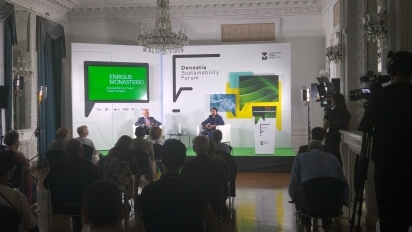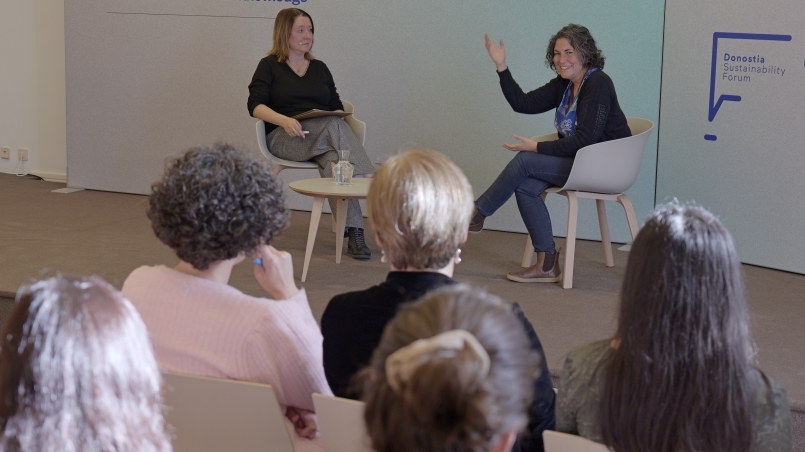The energy revolution involves electricity
<p> Transition is evolution. Energy transition, a path to follow to reach something new based on a rational use of energy, use of renewables and sustainable development. </p>

Enrique Monasterio, head of Development and Innovation at the Basque energy organisation EVE, reviewed the evolution of the energy we use. In 1982, when EVE was set up, 24% of the energy in the Basque Country came from coal, 62% from oil and gas hardly existed (0.6%). In the 80s and 90s the choice was gas and then renewables were introduced to replace coal and reduce dependence on oil derivatives. Today, producing renewable energy is much cheaper than 30 years ago. Advances in energy storage have led to a scenario where lithium batteries have a reasonable cost.
Enrique Monasterio said that the coming transition will be much faster from now on: "There is clear public awareness of climate change and also interest by consumers in taking part in the system, producing their own energy, clean, local energy." Public awareness of climate change and its effect on health is one of the fundamental factors in the "energy revolution". In Europe there are also geopolitical reasons not to depend on energy from other countries. A series of circumstances that are leading consumers to accept a new energy model. Enrique Monasterio talked about a new culture of energy that will bring us to a 100% renewable model.
Nearly all energy will be electrical in origin.
"If what drives everything is the struggle against climate change, emissions of greenhouse gases must be reduced. To carry on using energy it will be necessary to totally eliminate fossil fuels, and renewable energy is nearly all electrical energy. In the end consumption is being electrified. Mobility will be electric and even domestic heating will move in the same direction."
Electrical energy, if it is renewable, may also be the best solution for heating, in contrast to what was thought in the past. The priority of reducing consumption is another of the axioms that may change as the priority is becoming proper management of demand and making better use of a renewable resource. Such management does not always mean less consumption, but adapting the supply of cheap energy at particular times to demand.
Internal combustion engines in cars are no longer a guarantee of autonomy. There are already towns and cities in which they are banned and electric cars already have a range of 400-500 km. How often do we do more than 400 km in a single day? The batteries for these vehicles cost 1,000 dollars per kilowatt ten years ago; now they cost 150, and the lithium used to produce them is recyclable. Referring to the public uncertainty that is slowing down the switch to electric mobility, Enrique Monasterio encouraged people to buy electric cars. In four years the price of electric and internal combustion cars will be the same.
This fall in prices, which could not have been predicted until recently, also applies to solar and wind power, and the saving on lighting (LEDs have allowed a 95% reduction in comparison to incandescent bulbs), were the examples given by Enrique Monasterio for focusing on SMART Energy. Energy infrastructure will be digitally controlled, providing consumers with all the information they need on power generation at any time.
Hydrogen is going to play different roles. One of them will be to cope with times of peak demand. When excess energy is produced, this can be used to generate hydrogen, which in turn will generate electricity when demand requires it. Hydrogen as a fuel has a bright future in sectors like aviation, ships and long-distance lorries, where electrification is more difficult.
While today 40% of the energy consumed is renewable, by 2030 this will be 74%, rising to 100% by 2050, according to the Spanish government plan submitted to Brussels. Enrique Monasterio gave another figure: of all the installed electrical power in Spain, half is renewable, and also there is such a large number of applications to feed into the grid that the total installed power can be doubled. Photovoltaic power, which is going to increase exponentially in southern Europe, is generated during the day, so that daytime tariffs will fall and companies that currently work at night to save money (the steel industry, for example) will stop doing this. In the Basque Country, following the new regulations, photovoltaic energy began to take off in 2019, coinciding with the Ekian project (a plant installed in Araba province), and Monasterio foresees rapid growth here.
New consumer/manager
The consumer can use and pay for electricity, but they also have the possibility of generating it. Using it, selling it and sharing it with their neighbours. Something unthinkable just 2 years ago. Consumers will be generating and managing the energy they use and even entering the realm of storing it. The figure of the aggregator has also emerged: this brings together a group of consumers wishing to play a role on the market.
Big energy companies all over the world have noticed this substantial change and begun to adapt because new distributors have also emerged (some in a quasi-cooperative form), guaranteeing 100% renewable energy and offering consumers a new option.

